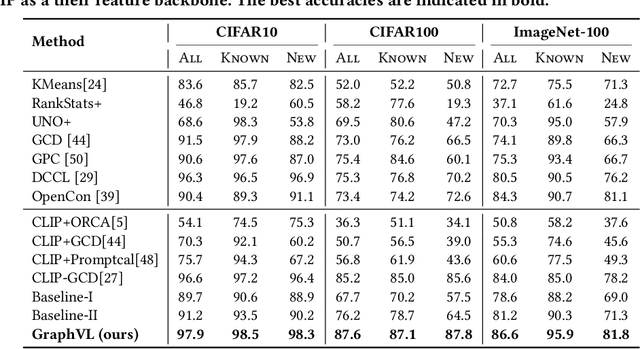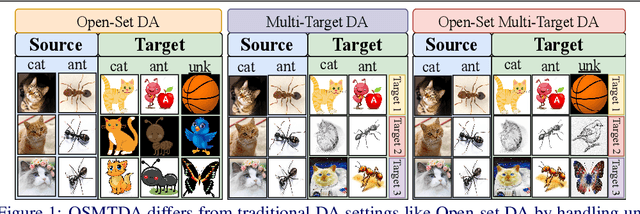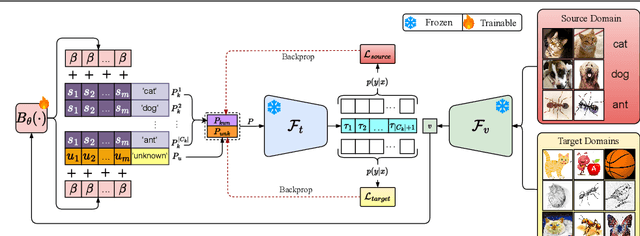Ankit Jha
FedMVP: Federated Multi-modal Visual Prompt Tuning for Vision-Language Models
Apr 29, 2025Abstract:Textual prompt tuning adapts Vision-Language Models (e.g., CLIP) in federated learning by tuning lightweight input tokens (or prompts) on local client data, while keeping network weights frozen. Post training, only the prompts are shared by the clients with the central server for aggregation. However, textual prompt tuning often struggles with overfitting to known concepts and may be overly reliant on memorized text features, limiting its adaptability to unseen concepts. To address this limitation, we propose Federated Multimodal Visual Prompt Tuning (FedMVP) that conditions the prompts on comprehensive contextual information -- image-conditioned features and textual attribute features of a class -- that is multimodal in nature. At the core of FedMVP is a PromptFormer module that synergistically aligns textual and visual features through cross-attention, enabling richer contexual integration. The dynamically generated multimodal visual prompts are then input to the frozen vision encoder of CLIP, and trained with a combination of CLIP similarity loss and a consistency loss. Extensive evaluation on 20 datasets spanning three generalization settings demonstrates that FedMVP not only preserves performance on in-distribution classes and domains, but also displays higher generalizability to unseen classes and domains when compared to state-of-the-art methods. Codes will be released upon acceptance.
OSLoPrompt: Bridging Low-Supervision Challenges and Open-Set Domain Generalization in CLIP
Mar 20, 2025Abstract:We introduce Low-Shot Open-Set Domain Generalization (LSOSDG), a novel paradigm unifying low-shot learning with open-set domain generalization (ODG). While prompt-based methods using models like CLIP have advanced DG, they falter in low-data regimes (e.g., 1-shot) and lack precision in detecting open-set samples with fine-grained semantics related to training classes. To address these challenges, we propose OSLOPROMPT, an advanced prompt-learning framework for CLIP with two core innovations. First, to manage limited supervision across source domains and improve DG, we introduce a domain-agnostic prompt-learning mechanism that integrates adaptable domain-specific cues and visually guided semantic attributes through a novel cross-attention module, besides being supported by learnable domain- and class-generic visual prompts to enhance cross-modal adaptability. Second, to improve outlier rejection during inference, we classify unfamiliar samples as "unknown" and train specialized prompts with systematically synthesized pseudo-open samples that maintain fine-grained relationships to known classes, generated through a targeted query strategy with off-the-shelf foundation models. This strategy enhances feature learning, enabling our model to detect open samples with varied granularity more effectively. Extensive evaluations across five benchmarks demonstrate that OSLOPROMPT establishes a new state-of-the-art in LSOSDG, significantly outperforming existing methods.
Foundation Models and Adaptive Feature Selection: A Synergistic Approach to Video Question Answering
Dec 12, 2024
Abstract:This paper tackles the intricate challenge of video question-answering (VideoQA). Despite notable progress, current methods fall short of effectively integrating questions with video frames and semantic object-level abstractions to create question-aware video representations. We introduce Local-Global Question Aware Video Embedding (LGQAVE), which incorporates three major innovations to integrate multi-modal knowledge better and emphasize semantic visual concepts relevant to specific questions. LGQAVE moves beyond traditional ad-hoc frame sampling by utilizing a cross-attention mechanism that precisely identifies the most relevant frames concerning the questions. It captures the dynamics of objects within these frames using distinct graphs, grounding them in question semantics with the miniGPT model. These graphs are processed by a question-aware dynamic graph transformer (Q-DGT), which refines the outputs to develop nuanced global and local video representations. An additional cross-attention module integrates these local and global embeddings to generate the final video embeddings, which a language model uses to generate answers. Extensive evaluations across multiple benchmarks demonstrate that LGQAVE significantly outperforms existing models in delivering accurate multi-choice and open-ended answers.
In the Era of Prompt Learning with Vision-Language Models
Nov 07, 2024

Abstract:Large-scale foundation models like CLIP have shown strong zero-shot generalization but struggle with domain shifts, limiting their adaptability. In our work, we introduce \textsc{StyLIP}, a novel domain-agnostic prompt learning strategy for Domain Generalization (DG). StyLIP disentangles visual style and content in CLIP`s vision encoder by using style projectors to learn domain-specific prompt tokens and combining them with content features. Trained contrastively, this approach enables seamless adaptation across domains, outperforming state-of-the-art methods on multiple DG benchmarks. Additionally, we propose AD-CLIP for unsupervised domain adaptation (DA), leveraging CLIP`s frozen vision backbone to learn domain-invariant prompts through image style and content features. By aligning domains in embedding space with entropy minimization, AD-CLIP effectively handles domain shifts, even when only target domain samples are available. Lastly, we outline future work on class discovery using prompt learning for semantic segmentation in remote sensing, focusing on identifying novel or rare classes in unstructured environments. This paves the way for more adaptive and generalizable models in complex, real-world scenarios.
GraphVL: Graph-Enhanced Semantic Modeling via Vision-Language Models for Generalized Class Discovery
Nov 04, 2024



Abstract:Generalized Category Discovery (GCD) aims to cluster unlabeled images into known and novel categories using labeled images from known classes. To address the challenge of transferring features from known to unknown classes while mitigating model bias, we introduce GraphVL, a novel approach for vision-language modeling in GCD, leveraging CLIP. Our method integrates a graph convolutional network (GCN) with CLIP's text encoder to preserve class neighborhood structure. We also employ a lightweight visual projector for image data, ensuring discriminative features through margin-based contrastive losses for image-text mapping. This neighborhood preservation criterion effectively regulates the semantic space, making it less sensitive to known classes. Additionally, we learn textual prompts from known classes and align them to create a more contextually meaningful semantic feature space for the GCN layer using a contextual similarity loss. Finally, we represent unlabeled samples based on their semantic distance to class prompts from the GCN, enabling semi-supervised clustering for class discovery and minimizing errors. Our experiments on seven benchmark datasets consistently demonstrate the superiority of GraphVL when integrated with the CLIP backbone.
COSMo: CLIP Talks on Open-Set Multi-Target Domain Adaptation
Aug 31, 2024



Abstract:Multi-Target Domain Adaptation (MTDA) entails learning domain-invariant information from a single source domain and applying it to multiple unlabeled target domains. Yet, existing MTDA methods predominantly focus on addressing domain shifts within visual features, often overlooking semantic features and struggling to handle unknown classes, resulting in what is known as Open-Set (OS) MTDA. While large-scale vision-language foundation models like CLIP show promise, their potential for MTDA remains largely unexplored. This paper introduces COSMo, a novel method that learns domain-agnostic prompts through source domain-guided prompt learning to tackle the MTDA problem in the prompt space. By leveraging a domain-specific bias network and separate prompts for known and unknown classes, COSMo effectively adapts across domain and class shifts. To the best of our knowledge, COSMo is the first method to address Open-Set Multi-Target DA (OSMTDA), offering a more realistic representation of real-world scenarios and addressing the challenges of both open-set and multi-target DA. COSMo demonstrates an average improvement of $5.1\%$ across three challenging datasets: Mini-DomainNet, Office-31, and Office-Home, compared to other related DA methods adapted to operate within the OSMTDA setting. Code is available at: https://github.com/munish30monga/COSMo
Elevating All Zero-Shot Sketch-Based Image Retrieval Through Multimodal Prompt Learning
Jul 05, 2024Abstract:We address the challenges inherent in sketch-based image retrieval (SBIR) across various settings, including zero-shot SBIR, generalized zero-shot SBIR, and fine-grained zero-shot SBIR, by leveraging the vision-language foundation model, CLIP. While recent endeavors have employed CLIP to enhance SBIR, these approaches predominantly follow uni-modal prompt processing and overlook to fully exploit CLIP's integrated visual and textual capabilities. To bridge this gap, we introduce SpLIP, a novel multi-modal prompt learning scheme designed to operate effectively with frozen CLIP backbones. We diverge from existing multi-modal prompting methods that either treat visual and textual prompts independently or integrate them in a limited fashion, leading to suboptimal generalization. SpLIP implements a bi-directional prompt-sharing strategy that enables mutual knowledge exchange between CLIP's visual and textual encoders, fostering a more cohesive and synergistic prompt processing mechanism that significantly reduces the semantic gap between the sketch and photo embeddings. In addition to pioneering multi-modal prompt learning, we propose two innovative strategies for further refining the embedding space. The first is an adaptive margin generation for the sketch-photo triplet loss, regulated by CLIP's class textual embeddings. The second introduces a novel task, termed conditional cross-modal jigsaw, aimed at enhancing fine-grained sketch-photo alignment, by focusing on implicitly modelling the viable patch arrangement of sketches using knowledge of unshuffled photos. Our comprehensive experimental evaluations across multiple benchmarks demonstrate the superior performance of SpLIP in all three SBIR scenarios. Code is available at https://github.com/mainaksingha01/SpLIP.
CDAD-Net: Bridging Domain Gaps in Generalized Category Discovery
Apr 08, 2024Abstract:In Generalized Category Discovery (GCD), we cluster unlabeled samples of known and novel classes, leveraging a training dataset of known classes. A salient challenge arises due to domain shifts between these datasets. To address this, we present a novel setting: Across Domain Generalized Category Discovery (AD-GCD) and bring forth CDAD-NET (Class Discoverer Across Domains) as a remedy. CDAD-NET is architected to synchronize potential known class samples across both the labeled (source) and unlabeled (target) datasets, while emphasizing the distinct categorization of the target data. To facilitate this, we propose an entropy-driven adversarial learning strategy that accounts for the distance distributions of target samples relative to source-domain class prototypes. Parallelly, the discriminative nature of the shared space is upheld through a fusion of three metric learning objectives. In the source domain, our focus is on refining the proximity between samples and their affiliated class prototypes, while in the target domain, we integrate a neighborhood-centric contrastive learning mechanism, enriched with an adept neighborsmining approach. To further accentuate the nuanced feature interrelation among semantically aligned images, we champion the concept of conditional image inpainting, underscoring the premise that semantically analogous images prove more efficacious to the task than their disjointed counterparts. Experimentally, CDAD-NET eclipses existing literature with a performance increment of 8-15% on three AD-GCD benchmarks we present.
Unknown Prompt, the only Lacuna: Unveiling CLIP's Potential for Open Domain Generalization
Mar 31, 2024Abstract:We delve into Open Domain Generalization (ODG), marked by domain and category shifts between training's labeled source and testing's unlabeled target domains. Existing solutions to ODG face limitations due to constrained generalizations of traditional CNN backbones and errors in detecting target open samples in the absence of prior knowledge. Addressing these pitfalls, we introduce ODG-CLIP, harnessing the semantic prowess of the vision-language model, CLIP. Our framework brings forth three primary innovations: Firstly, distinct from prevailing paradigms, we conceptualize ODG as a multi-class classification challenge encompassing both known and novel categories. Central to our approach is modeling a unique prompt tailored for detecting unknown class samples, and to train this, we employ a readily accessible stable diffusion model, elegantly generating proxy images for the open class. Secondly, aiming for domain-tailored classification (prompt) weights while ensuring a balance of precision and simplicity, we devise a novel visual stylecentric prompt learning mechanism. Finally, we infuse images with class-discriminative knowledge derived from the prompt space to augment the fidelity of CLIP's visual embeddings. We introduce a novel objective to safeguard the continuity of this infused semantic intel across domains, especially for the shared classes. Through rigorous testing on diverse datasets, covering closed and open-set DG contexts, ODG-CLIP demonstrates clear supremacy, consistently outpacing peers with performance boosts between 8%-16%. Code will be available at https://github.com/mainaksingha01/ODG-CLIP.
C-SAW: Self-Supervised Prompt Learning for Image Generalization in Remote Sensing
Nov 27, 2023Abstract:We focus on domain and class generalization problems in analyzing optical remote sensing images, using the large-scale pre-trained vision-language model (VLM), CLIP. While contrastively trained VLMs show impressive zero-shot generalization performance, their effectiveness is limited when dealing with diverse domains during training and testing. Existing prompt learning techniques overlook the importance of incorporating domain and content information into the prompts, which results in a drop in performance while dealing with such multi-domain data. To address these challenges, we propose a solution that ensures domain-invariant prompt learning while enhancing the expressiveness of visual features. We observe that CLIP's vision encoder struggles to identify contextual image information, particularly when image patches are jumbled up. This issue is especially severe in optical remote sensing images, where land-cover classes exhibit well-defined contextual appearances. To this end, we introduce C-SAW, a method that complements CLIP with a self-supervised loss in the visual space and a novel prompt learning technique that emphasizes both visual domain and content-specific features. We keep the CLIP backbone frozen and introduce a small set of projectors for both the CLIP encoders to train C-SAW contrastively. Experimental results demonstrate the superiority of C-SAW across multiple remote sensing benchmarks and different generalization tasks.
 Add to Chrome
Add to Chrome Add to Firefox
Add to Firefox Add to Edge
Add to Edge